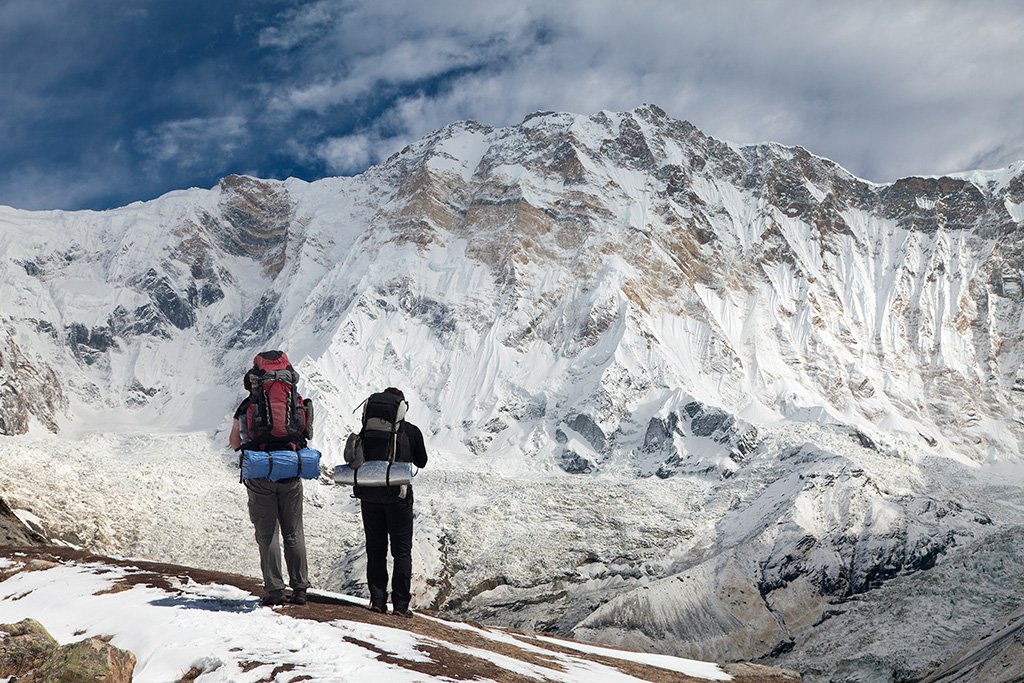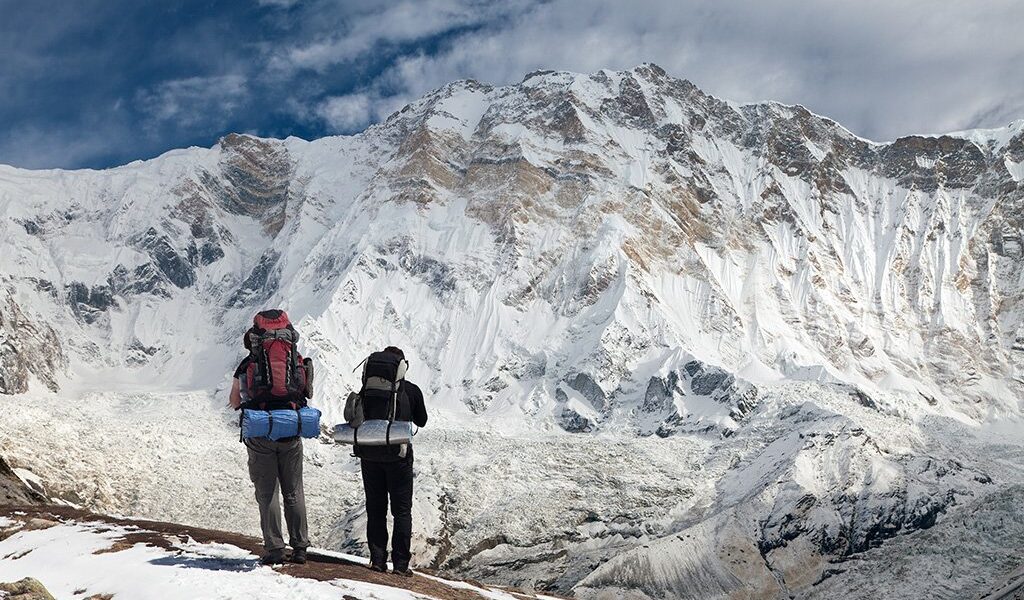
Visiting Nepal in December, January or February? Winter is a great season for shorter treks at lower elevations. The temperatures are colder, but if you’re well prepared you can enjoy clear skies and fewer crowds.
Key Advantages of Winter Treks
- Experience unparalleled mountain vistas, most vibrant during the winter months, thanks to consistently clear atmospheric conditions. The absence of monsoonal clouds provides unobstructed panoramas.
- Delight in trekking some of Nepal’s most beloved trails, such as the iconic Poon Hill trek, with the added bonus of relative solitude. Escape the usual throngs of tourists and savor the tranquility.
- Take advantage of the low season to secure exceptional deals on superior hotel accommodations. Enjoy luxury and comfort without the peak-season price tag.
- Despite the chill of the winter nights, the daytime weather offers ideal conditions for trekking, characterized by ample sunshine and minimal precipitation, making your journey pleasant and safe.
Comprehensive Overview of Winter Trekking in Nepal
While spring and autumn traditionally hold the crown as the most sought-after seasons for visiting Nepal, embarking on a trek during the winter months unveils a collection of distinct and captivating advantages. From December through February, rainfall becomes a rare occurrence, gifting visitors with consistently pristine and transparent skies. This translates directly into the mountain views reaching their absolute zenith, showcasing the breathtaking landscapes with unparalleled clarity. Given that winter is recognized as the off-season, travelers will encounter a newfound ease in securing lodging at teahouses nestled along the trekking routes, as well as obtaining more affordable rates at hotels and guesthouses throughout Nepal’s vibrant cities. What’s more, the trails themselves become significantly less congested, affording trekkers the unique opportunity to immerse themselves in the awe-inspiring scenery with a sense of peaceful solitude and unadulterated wonder.
While the lower altitudes of Nepal, encompassing cities such as Kathmandu and Pokhara, generally maintain relatively mild temperatures and remain untouched by snowfall, it is crucial to acknowledge that as you ascend to higher elevations, the thermometer readings will inevitably plummet. This implies that certain treks situated at higher altitudes may not be optimally suited for winter exploration, and some routes might even become entirely impassable due to accumulating snow. To ensure a more comfortable and secure trekking experience during the winter months, it is advisable to prioritize routes that remain below the 4000-meter mark. It is also worth noting that Nepal’s winter season is relatively short-lived. Therefore, strategically planning your visit for early December or late February can increase your chances of encountering milder and more temperate weather conditions.
Average Winter Temperatures in Key Locations
| Location | December | January | February |
|---|---|---|---|
| Kathmandu | 46-70°F (8-21°C) | 40-62°F (4-17°C) | 40-67°F (4-19°C) |
| Pokhara | 46-70°F (8-21°C) | 45-66°F (7-19°C) | 48-70°F (9-21°C) |
| Namche Bazaar | 20-45°F (-6.50-7.6°C) | 18-43°F (-8-6°C) | 21-43°F (-6-6°C) |
| Jomsom | 32-59°F (0-15°C) | 32-53°F (0-12°C) | 33-55°F (1-13°C) |
| Chitwan | 46-75°F (8-24°C) | 44-75°F (7-24°C) | 46-79°F (8-26°C) |
| *Temperatures shown are average min/max tempartures for those months | |||
Connect with a knowledgeable local expert who can assist you in designing and organizing your perfect trip to Nepal. Benefit from their insider knowledge and personalized recommendations.
Everest Panorama Trek: A Taste of the Himalayas
While the ambitious trek to Everest Base Camp remains a possibility even during the winter months, it’s crucial to acknowledge that the high altitude, reaching a staggering 5335 meters, significantly amplifies the challenges posed by the already frigid temperatures. For those seeking a more comfortable and accessible introduction to the majestic Everest region, exploring one of the shorter treks in the vicinity is a highly recommended alternative. These offer breathtaking scenery without the extreme physical demands.
With a carefully planned five-day itinerary, you can embark on an unforgettable journey that begins with a scenic flight from Kathmandu to the charming town of Lukla. From there, a trek to Namche Bazaar, the vibrant epicenter of Sherpa culture, awaits. Using Namche as your convenient base of operations, you can venture on a captivating hike to the picturesque village of Thame, where you’ll discover a stunning monastery gracefully perched high upon the dramatic cliffs. Extending your adventure to seven days allows you to continue your trek onward to the enchanting village of Tengboche, further immersing yourself in the region’s natural beauty and cultural richness.
In Tengboche, you’ll have the invaluable opportunity to visit the renowned monastery of Dawa Choling Gompa, a sacred site where climbers and trekkers traditionally seek the blessings of the Head Lama for a safe and successful expedition. Beyond its spiritual significance, Tengboche also boasts unparalleled, close-up vistas of the majestic Ama Dablam, a mountain that undoubtedly earns its reputation as one of the most visually stunning peaks in the entire world.
Poon Hill Trek: A Classic for a Reason
During the peak tourist seasons, the Poon Hill trek, which meanders through the charming villages of Ghorepani and Ghandruk, experiences immense popularity, often leading to crowded conditions at the dawn lookout point. However, the winter season presents a refreshing contrast, offering a more serene and intimate experience. This trek’s enduring appeal is well-deserved, as it guides you through idyllic local villages, verdant forests brimming with diverse vegetation, and culminates in breathtaking sunrise panoramas from the vantage point of Poon Hill, situated at an elevation of 3210 meters. One of the most compelling advantages of this trek lies in its ease of accessibility and its capacity to deliver remarkably close-up views of the towering Himalayan giants, including Annapurna and Dhaulagiri, without requiring an excessively high ascent. This makes it an especially attractive option for those trekking during the winter months, as it balances accessibility with awe-inspiring scenery.
Khopra Danda Trek: Venture Off the Beaten Path
While the Poon Hill trek can be efficiently completed in as few as three days, extending your adventure with the Khopra Danda extension unlocks a more immersive and secluded experience. Even during the bustling peak seasons, the Khopra Danda trek remains relatively undiscovered, ensuring that you’ll likely have the trails all to yourself during the tranquil winter months. The initial segment of the route mirrors that of the Poon Hill trek for the first couple of days, after which a distinct local trail leads you down into the picturesque valley situated north of Ghorepani. From there, the path ascends towards Khopra Ridge, reaching an elevation of 3640 meters. Throughout this trek, you’ll be treated to magnificent vistas of iconic peaks such as Annapurna, Dhaulagiri, and the distinctive Machhapuchhre, also known as Fishtail, enriching your journey with unparalleled natural beauty.
Kathmandu Valley Trek: Explore the Heart of Nepal
The Kathmandu Valley maintains a comparatively mild climate throughout the winter season, rendering it an ideal destination for indulging in shorter hikes at lower altitudes. An excellent 2-3 day trek will lead you from the bustling Kathmandu city to the tranquil hill station of Nagarkot, continuing onward to the historic town of Dhulikhel and ultimately descending to the culturally rich city of Bhaktapur. Nagarkot and Dhulikhel, both venerable Newari towns nestled just outside the Valley, offer spectacular Himalayan views when the weather is clear, a condition that is frequently encountered during the winter months. These towns boast a variety of inviting guesthouses and homestays, catering to a range of budgetary preferences. For those seeking a more opulent experience, Dwarika’s Dhulikel offers an unparalleled level of luxury and comfort. Alternatively, for a more budget-conscious option, the Nagarkot Farmhouse provides a charming and affordable retreat.
In addition to these multi-day treks, the Kathmandu Valley also presents a plethora of exceptional day hike opportunities, allowing you to return to the cozy warmth of your well-heated Kathmandu hotel at the conclusion of each day. The Valley’s highest peaks, including Phulchoki and Champadevi, provide challenging yet rewarding day hikes, offering breathtaking panoramas of both the city and the surrounding mountains. Similarly, a hike within the boundaries of the Shivapuri National Park promises an immersive experience in Nepal’s natural beauty.
Chitwan: A Tropical Escape
For a departure from the mountainous terrain, consider venturing south to the Chitwan National Park, nestled on Nepal’s expansive flat plains, where the climate remains consistently mild. While the park is renowned for its population of elephants and rhinos, it also boasts an array of excellent hiking trails. The Chitwan Hills Trail guides you towards Siraichuli Hill, one of the highest points in the Mahabharat range, soaring to an elevation of 1,945 meters. From this vantage point, you can witness truly spectacular sunrises and sunsets, as well as panoramic views encompassing the vast plains and the distant Himalayan peaks, creating an unforgettable visual tapestry.
Essential Clothing Recommendations
Adequate preparation for a diverse range of weather conditions is paramount when trekking in Nepal, irrespective of the time of year. However, this becomes particularly critical during the winter months, emphasizing the need for sufficient warm layers. While daytime temperatures in Nepal can be relatively mild even in winter, temperatures at higher elevations can plummet to below freezing. It is highly probable that you will need to remove your outer layers during the day while actively trekking, making a high-quality down coat an indispensable item. Down jackets are not only lightweight and easy to carry but also provide exceptional warmth when the sun begins to set. Moreover, good woollen hats, gloves, socks, and scarves are essential components of your winter trekking wardrobe.
Virtually all necessary winter trekking equipment can be readily purchased or rented from the numerous trekking shops located in Thamel, Kathmandu. Depending on the duration of your trek and the anticipated degree of cold, it is prudent to consider bringing your own winter gear. While teahouses typically provide blankets, bringing a compact sleeping bag for added warmth is highly recommended.
Here’s a comprehensive list of essential winter gear to bring with you to Nepal:
- A warm winter sleeping bag (ideally down-filled)
- Several pairs of warm, moisture-wicking socks
- Versatile layers (including a t-shirt, long-sleeved shirt, and a down jacket)
- A pair of insulated gloves and a warm toque (beanie)
- High-SPF sunscreen and UV-protective sunglasses
B-1791

